COMPOUNDS OF BORON
Borax
Preparation
It occurs naturally as tineal in dried up lakes. It is obtained by boiling of mineral colemanite with a solution of Na2Co3.

NaBO2can be removed by passing CO2through it.
4NaBO2+ CO2→ Na2CO3+ Na2B<4O7
Properties
1. Its aqueous solution is basic in nature.
Na2B4O7+ 7H2O → 2NaOH + 4H3BO3
2. On heating with ethyl alcohol and cone.H2SO4it gives volatile vapours of triethyl borate which burn with a green flame.

3. Action of heat

Borax bead is used for the detection of coloured basic radicals under the name borax bead test e.g.,
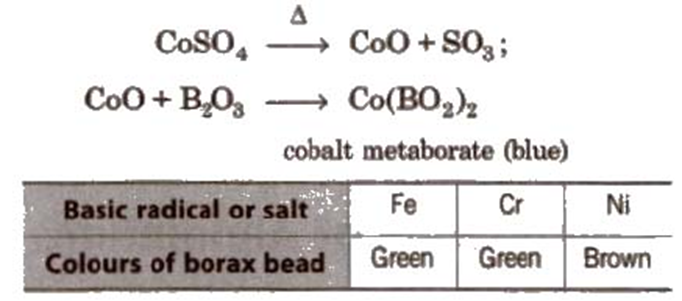
Orthoboric acid
PREPARATION
- By treating borax with dil HCl or dil H2SO4
Na2B4O7 + 2HCl + 5H2O ![]() 2NaCl +4H3BO3
2NaCl +4H3BO3
- By passing SO2 through a mixture of powdered mineral colemanite in boiling water.
Ca2B6O11 + 4SO2 + 11H2O 2Ca(HSO3)2 +6H3BO3
2Ca(HSO3)2 +6H3BO3
PROPERTIES
It is a very weak monobasic acid. It does not act as a proton donor but accepts a hydroxyl ion i.e., it behaves as a lewis acid.
H3BO3 + H2O![]() [B(OH)4]– + H +
[B(OH)4]– + H +
With C2H5OH and conc. H2SO4, it gives triethylborate.
H3BO3 + 3C2H5OH![]() B(OC2H5)3 +3H2O
B(OC2H5)3 +3H2O
With NaOH, it gives sodium metaborate
H3BO3 + NaOH![]() NaBO2 + 2H2O
NaBO2 + 2H2O
Heating effect
H3BO3 ![]() HBO2
HBO2 ![]() 2B4O7
2B4O7![]() 2O3
2O3
USES
As an antiseptic and eye lotion under the name Boric lotion, and as a food preservative.
STRUCTURE
It has a layer structure in which planar ![]() units are linked by H- bonding, as shown in fig.
units are linked by H- bonding, as shown in fig.
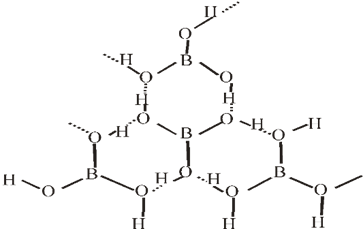
Diborane
The simplest boron hydride known, is diborane. It is prepared by treating boron trifluoride with LiAlH4in diethyl ether.
4BF3+ 3 LiAlH4→2B2H6+ 3LiF + 3AlF3
A convenient laboratory method for the preparation of diborane involves the oxidation of sodium borohydride with iodine.
2NaBH4+ I2→B2H6+ 2NaI + H2
Diborane is produced on an industrial scale by the reaction of BF3with sodium hydride.
![]()
Diborane is a colourless, highly toxic gas with a b.p. of 180 K. Diborane catches fire spontaneously upon exposure to air. It burns in oxygen releasing an enormous amount of energy.

Most of the higher boranes are also spontaneously flammable in air. Boranes are readily hydrolysed by water to give boric acid.
B2H6(g) + 6H2O(l)→2B(OH)3(aq) + 6H2(g)
Diborane undergoes cleavage reactions with Lewis bases(L) to give borane adducts, BH3⋅L
B2H6+ 2 NMe3→2BH3⋅NMe3
B2H6+ 2 CO→2BH3⋅CO
Reaction of ammonia with diborane gives initially B2H6.2NH3which is formulated as [BH2(NH3)2]+[BH4]–; further heating gives borazine, B3N3H6known as “inorganic benzene” in view of its ring structure with alternate BH and NH groups.

The structure of diborane is shown in Fig. The four terminal hydrogen atoms and the two boron atoms lie in one plane. Above and below this plane, there are two bridging hydrogen atoms. The four terminal B-H bonds are regular two centre-two electron bonds while the two bridge (B-H-B) bonds are different and can be described in terms of three centre–twoelectron bonds shown in Fig.

Boron also forms a series of hydridoborates; the most important one is the tetrahedral [BH4]–ion. Tetrahydridoborates of several metals are known. Lithium and sodium tetra-hydridoborates, also known asborohydrides, are prepared by the reaction of metal hydrides with B2H6in diethyl ether.
2MH + B2H6→2 M+[BH4]–(M = Li or Na)
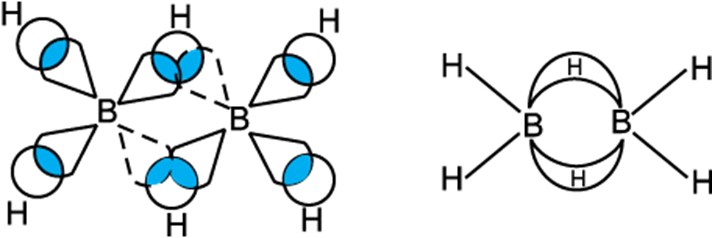
Bonding in diborane. Each B atom uses sp3hybrids for bonding. Out
of the four sp3hybrids on each B atom, one is without an electron shown in broken lines. The terminal B-H bonds are normal 2-centre-2-electron bonds but the two bridge bonds are 3-centre-2-electron bonds. The 3-centre-2-electron bridge bonds are also referred to as banana bonds.
Both LiBH4and NaBH4 are used as reducing agents in organic synthesis. They are useful starting materials for preparing other metal borohydrides.
Boron halides
PREPARATION
By the reaction of boron and halogens at high temperature.
2B + 3X2  2BX3
2BX3
PROPERTIES
· BF3 and BCl3 are gases, BBr3 is a volatile liquid and BI3 is a solid at room temperature.
· These are covalent in nature and act as lewis acids. The decreasing order of acid strength is. BI3 > BBr3 > BCl3 > BF3
Boron nitride
It is a colourless liquid having a six membered ring of alternating B and N atoms. It is also called inorganic benzene. It is prepared by B2H6 as follows:
3B2H6 + 6NH3![]() 2B3N3H6 + 12H2
2B3N3H6 + 12H2
The p electrons in borazine are only partially delocalised. It is much more reactive than benzene, because there is a retention of partial negative charge by nitrogen atoms in latter case. It is isosteric (presence of same number of atoms and electrons) with benzene.
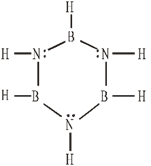
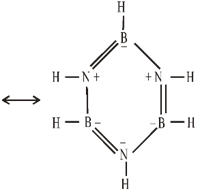
Borazine